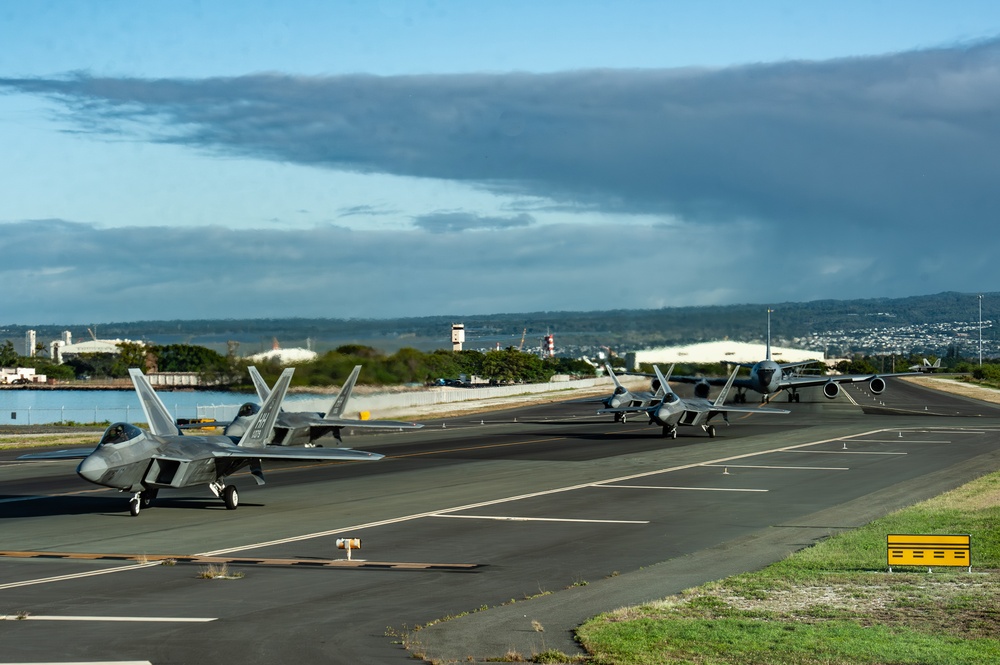The Hawaii Air National Guard’s (HIANG) 154th Wing successfully concluded their long running defense readiness exercise Sentry Aloha on Joint Base Pearl Harbor-Hickam, Hawaii, Feb. 12, 2025.
Designated Sentry Aloha 25-1, this iteration began Jan. 29 and brought approximately 800 joint personnel including Guardsman, Reservists, locally-based active duty partners from the 15th Wing, Sailors and Marines and nearly 30 aircraft from six states.
For more than 20 years, Sentry Aloha is an ongoing series of exercises that enable tailored, cost effective and realistic combat training for Air National Guard, U.S. Air Force, and other Department of Defense services. It provides U.S. war fighters with the skill sets necessary to perform homeland defense and overseas combat missions.
Sentry Aloha is built around Dissimilar Air Combat Training (DACT), which challenges pilots to engage in combat scenarios against aircraft with different performance capabilities. Rather than training against identical airframes, DACT forces pilots to adapt to unpredictable engagements, testing their ability to exploit their own platform’s strengths while capitalizing on adversary weaknesses.
The exercise operates at an intense tempo, with participants generating back-to-back combat training sorties daily. This high-paced battle rhythm ensures pilots experience continuous exposure to varied threats, refining their decision-making, reaction times and overall combat effectiveness in a dynamic and ever-evolving air combat environment.
Guest participants included U.S. Navy F-35C Lightning II’s from California, and U.S. Air National Guard KC-135 Stratotankers from Washington and Mississippi. Visiting aircraft took part in simulated combat exercises with F-22A Raptors operated by the 199th and 19th Fighter Squadrons’ Hickam based ‘Hawaiian Raptors.’
Joint maintenance teams launched, recovered, and maintained the diverse fleet of aircraft—comprising fifth-generation fighters, refueling tankers, and cargo aircraft for support and logistic capabilities—ensuring a seamless flow of sorties and a full-spectrum air combat scenario.
The successful execution of these flight operations highlights the importance of Hawaii’s strategic location and training environment.
“Hawaii offers great weather, especially over-water airspace to train in the Indo-Pacific Theater, as well as the opportunities to practice those agile combat employment tactics, techniques, and procedures,” said
U.S. Air Force Lt. Col. Matthew Ohman, 201st Combat Operations Squadron, Sentry Aloha senior director, “The Hawaiian Raptors rely heavily on these exercises to accomplish mission readiness – it’s a culmination of a lot of training.”
During this iteration of Sentry Aloha, the 169th Air Defense Squadron provided a team of Battle Management Operators aboard the KC-135 for the first time, delivering non-traditional tactical command and control to the forward edge. From the airborne platform, they relayed near real-time situational awareness provided via beyond line of sight communications by Air Battle Managers and Battle Management Operators on the ground utilizing a simulated Common Operational Picture, exercising fight tonight capabilities.
“The HIANG must continue to integrate,” said U.S. Air Force Tech. Sgt. Kukila Carreira-Manin,169th ADS, weapons and tactics NCO-in-charge, “Every service member within USINDOPACOM has a significant responsibility to support each other from every aspect in every rank. Time is precious within this theater and every second counts building our relationships with one another.”
The daily tanker support provided served as a force-multiplier, enabling fighter aircraft to extend their range and mission duration without the need for frequent landings to base, reducing congestion at the airport and creating efficient flight operations. By providing in-flight refueling, tankers allow participants to maximize their flight hours, conduct more extensive training scenarios, and remain engaged in exercises for longer periods to enhance operational effectiveness.
Agile Combat Employment (ACE) concepts were deployed and rehearsed among participants across the Hawaiian Islands. Among these systems were the implementation of a Tactical Operations Center-Lite (TOC-L) brought in by the 103rd Air Control Squadron from the Connecticut Air National Guard.
The mobile system is designed to be compact and ready for rapid deployment and advanced airspace tactical control. Unlike traditional systems that require extensive infrastructure and staffing, TOC-L integrates cloud-based command and control capabilities, enabling seamless operations worldwide. It can be packed into about two dozen hand-carried cases and be operational within an hour with minimal personnel.
“It was our most ambitious TOC-L execution to date,” said U.S. Air Force Maj. J. Seth Bopp, 103rd Air Control Squadron director of operations. “The team planned for months and built off of what they learned from similar exercises, such as AGILE PANDA, NIMBLE CHEETAH, MOBILE MARLIN, and SENTRY SAVANNAH. They did it faster and did it with more sites. We couldn’t have done it without our joint partners from the U.S. Marine Corps and the U.S. Space Force who acted as force enablers for our proof of concept.”
The 103rd ACS exercised a morning vulnerability from Kaneohe Marine Corps Base on Oahu, disassembled equipment, deployed from Oahu on a KC-130J Hercules to the Pacific Missile Range Facility on the neighboring island of Kauai, control vulnerability, and re-deployed back to Oahu in a five-hour window.
“Doing all of that in a short window across two islands was paramount in proving ACE concepts for TOC-L,” said Senior Master Sgt. Jonathan Burr, 103rd Air Control Squadron senior enlisted leader. “Traveling out from our home base in Connecticut and across the Hawaiian Islands, the team had to jump through hoops to make things happen and they were exceptional.”
Over a two-week span, the 103rd ACS trained and tested at three locations across two islands, and ended with four locations across three islands. It was the first time a unit was able to remote in two radio sites.
“I would say the 103rd definitely showed up ready to work and utilize their TOC-L system to kind of be the highlights, it’s definitely something new and different that we haven’t really done before.” said Ohman, “Everyone showed up and did the job they were ready and trained to do. I definitely would give credit to our tankers, it didn’t seem like during the exercise we had many or any tanker cancellations, but the tankers seemed to be flying well throughout the entire exercise.”
With 182 sorties flown and well over 300 flight hours logged, Sentry Aloha 25-1 successfully enhanced combat readiness and interoperability among participating units. The second phase of this year’s training is projected to be held in the first half of this year, bringing another opportunity to refine warfighting capabilities in the Indo-Pacific region.
| Date Taken: | 02.18.2025 |
| Date Posted: | 02.18.2025 17:46 |
| Story ID: | 490975 |
| Location: | JOINT BASE PEARL HARBOR-HICKAM, HAWAII, US |
| Web Views: | 12 |
| Downloads: | 0 |
PUBLIC DOMAIN

This work, HIANG’s Sentry Aloha 25-01 Bolsters Agile Combat Employment with Enhanced Mission Readiness, by SrA Roann Gatdula, identified by DVIDS, must comply with the restrictions shown on https://www.dvidshub.net/about/copyright.








